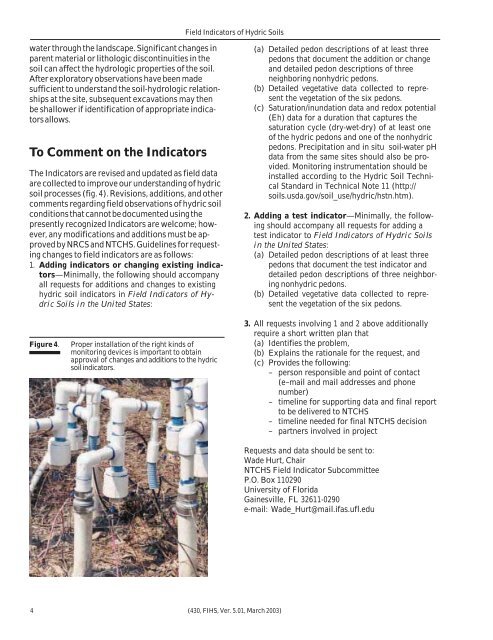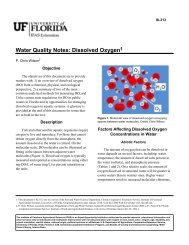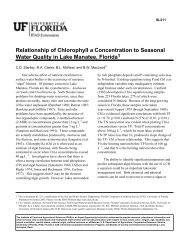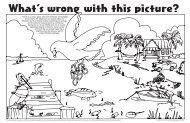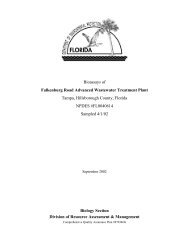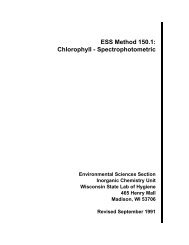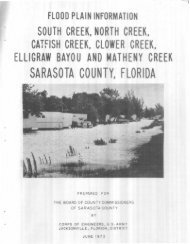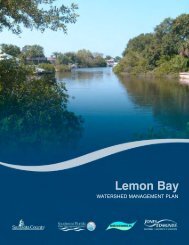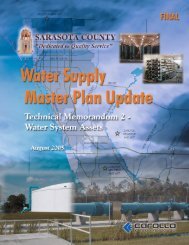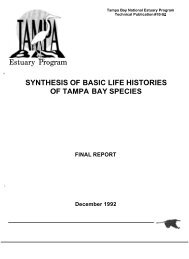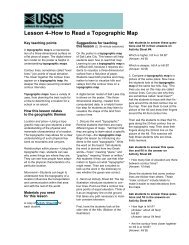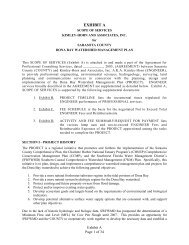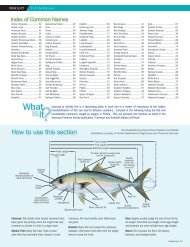Field Indicators of Hydric Soils in the United States - ITC
Field Indicators of Hydric Soils in the United States - ITC
Field Indicators of Hydric Soils in the United States - ITC
You also want an ePaper? Increase the reach of your titles
YUMPU automatically turns print PDFs into web optimized ePapers that Google loves.
<strong>Field</strong> <strong>Indicators</strong> <strong>of</strong> <strong>Hydric</strong> <strong>Soils</strong>water through <strong>the</strong> landscape. Significant changes <strong>in</strong>parent material or lithologic discont<strong>in</strong>uities <strong>in</strong> <strong>the</strong>soil can affect <strong>the</strong> hydrologic properties <strong>of</strong> <strong>the</strong> soil.After exploratory observations have been madesufficient to understand <strong>the</strong> soil-hydrologic relationshipsat <strong>the</strong> site, subsequent excavations may <strong>the</strong>nbe shallower if identification <strong>of</strong> appropriate <strong>in</strong>dicatorsallows.To Comment on <strong>the</strong> <strong>Indicators</strong>The <strong>Indicators</strong> are revised and updated as field dataare collected to improve our understand<strong>in</strong>g <strong>of</strong> hydricsoil processes (fig. 4). Revisions, additions, and o<strong>the</strong>rcomments regard<strong>in</strong>g field observations <strong>of</strong> hydric soilconditions that cannot be documented us<strong>in</strong>g <strong>the</strong>presently recognized <strong>Indicators</strong> are welcome; however,any modifications and additions must be approvedby NRCS and NTCHS. Guidel<strong>in</strong>es for request<strong>in</strong>gchanges to field <strong>in</strong>dicators are as follows:1. Add<strong>in</strong>g <strong>in</strong>dicators or chang<strong>in</strong>g exist<strong>in</strong>g <strong>in</strong>dicators—M<strong>in</strong>imally,<strong>the</strong> follow<strong>in</strong>g should accompanyall requests for additions and changes to exist<strong>in</strong>ghydric soil <strong>in</strong>dicators <strong>in</strong> <strong>Field</strong> <strong>Indicators</strong> <strong>of</strong> <strong>Hydric</strong><strong>Soils</strong> <strong>in</strong> <strong>the</strong> <strong>United</strong> <strong>States</strong>:(a) Detailed pedon descriptions <strong>of</strong> at least threepedons that document <strong>the</strong> addition or changeand detailed pedon descriptions <strong>of</strong> threeneighbor<strong>in</strong>g nonhydric pedons.(b) Detailed vegetative data collected to represent<strong>the</strong> vegetation <strong>of</strong> <strong>the</strong> six pedons.(c) Saturation/<strong>in</strong>undation data and redox potential(Eh) data for a duration that captures <strong>the</strong>saturation cycle (dry-wet-dry) <strong>of</strong> at least one<strong>of</strong> <strong>the</strong> hydric pedons and one <strong>of</strong> <strong>the</strong> nonhydricpedons. Precipitation and <strong>in</strong> situ soil-water pHdata from <strong>the</strong> same sites should also be provided.Monitor<strong>in</strong>g <strong>in</strong>strumentation should be<strong>in</strong>stalled accord<strong>in</strong>g to <strong>the</strong> <strong>Hydric</strong> Soil TechnicalStandard <strong>in</strong> Technical Note 11 (http://soils.usda.gov/soil_use/hydric/hstn.htm).2. Add<strong>in</strong>g a test <strong>in</strong>dicator—M<strong>in</strong>imally, <strong>the</strong> follow<strong>in</strong>gshould accompany all requests for add<strong>in</strong>g atest <strong>in</strong>dicator to <strong>Field</strong> <strong>Indicators</strong> <strong>of</strong> <strong>Hydric</strong> <strong>Soils</strong><strong>in</strong> <strong>the</strong> <strong>United</strong> <strong>States</strong>:(a) Detailed pedon descriptions <strong>of</strong> at least threepedons that document <strong>the</strong> test <strong>in</strong>dicator anddetailed pedon descriptions <strong>of</strong> three neighbor<strong>in</strong>gnonhydric pedons.(b) Detailed vegetative data collected to represent<strong>the</strong> vegetation <strong>of</strong> <strong>the</strong> six pedons.Figure 4.Proper <strong>in</strong>stallation <strong>of</strong> <strong>the</strong> right k<strong>in</strong>ds <strong>of</strong>monitor<strong>in</strong>g devices is important to obta<strong>in</strong>approval <strong>of</strong> changes and additions to <strong>the</strong> hydricsoil <strong>in</strong>dicators.3. All requests <strong>in</strong>volv<strong>in</strong>g 1 and 2 above additionallyrequire a short written plan that(a) Identifies <strong>the</strong> problem,(b) Expla<strong>in</strong>s <strong>the</strong> rationale for <strong>the</strong> request, and(c) Provides <strong>the</strong> follow<strong>in</strong>g:– person responsible and po<strong>in</strong>t <strong>of</strong> contact(e–mail and mail addresses and phonenumber)– timel<strong>in</strong>e for support<strong>in</strong>g data and f<strong>in</strong>al reportto be delivered to NTCHS– timel<strong>in</strong>e needed for f<strong>in</strong>al NTCHS decision– partners <strong>in</strong>volved <strong>in</strong> projectRequests and data should be sent to:Wade Hurt, ChairNTCHS <strong>Field</strong> Indicator SubcommitteeP.O. Box 110290University <strong>of</strong> FloridaGa<strong>in</strong>esville, FL 32611-0290e-mail: Wade_Hurt@mail.ifas.ufl.edu4 (430, FIHS, Ver. 5.01, March 2003)


